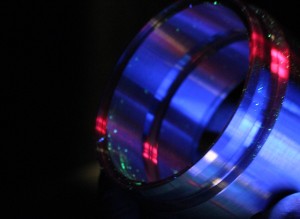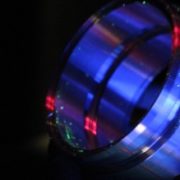Liquid Penetrant Inspection Is Economical and Versatile
 Liquid Penetrant Inspection is a nondestructive testing method used to reveal surface discontinuities by bleeding out a colored or fluorescent dye from the flaw. This process is called capillary action, where a liquid is drawn into a clean, dry defect through low surface tension.
Liquid Penetrant Inspection is a nondestructive testing method used to reveal surface discontinuities by bleeding out a colored or fluorescent dye from the flaw. This process is called capillary action, where a liquid is drawn into a clean, dry defect through low surface tension.
Liquid Penetrant Inspection (LPI), also known as Fluorescent Penetrant Inspection (FPI), is one of the two most common nondestructive testing methods, a process that tests for discontinuities without damaging parts in any way. The other method is Magnetic Particle Inspection (MPI), which is limited for use on magnetic parts.
If your parts are nonmagnetic, the only option is Liquid Penetrant Inspection. It relies on using either an ultraviolet light for a fluorescent liquid penetrant, or a white light for a visible dye penetrant.
The two penetrants are classified by their sensitivity levels. Visible penetrant is red in color and represents the lowest sensitivity. Fluorescent penetrants are yellow-green and contrast with the darkened environment, representing the highest sensitivity to defects.
Liquid Penetrant Inspection and Fluorescent Penetrant Inspection consist of 6 steps:
- Pre-cleaning the part to be free of all dirt, oil, grease, paint, rust, or any loose scale that could prevent the liquid from penetrating the defect or cause false indications. For most parts, PTI uses vapor degreasing with TriChloroethylene. Solvents such as MEK or Acetone are used to clean Titanium parts where Tri-Chlor may have adverse effects. Any defects present must be open to the surface, dry, and free of contamination.
- Application of penetrant to the part’s surface has a dwell or soak time that allows the penetrant to permeate into any cracks and voids. The dwell time can be from 5 to 30 minutes, depending on the material of the part and the size of the potential flaws. Smaller defects require a longer penetration time.
- Excess penetrant is removed from the part’s surface. This prevents the possibility of masking defects from the developer by leaving a background. Without proper removal, false indications may also occur. PTI generally uses water to wash the penetrant off.
- Application of developer follows drying time in a convection oven. A thin, light coating of developer is sprayed on the part and a dwell time is again observed. The developer draws the penetrant out, creating a visible indication or flaw in the developer known as a bleed-out.
- The part is inspected using visible light on a visible dye penetrant, typically with an intensity of 100 foot-candles or 1100 lux. Ultraviolet or black light is used for fluorescent penetrant examinations. The correct length of time is critical. The length of an indication can increase with time as the penetrant bleeds out, causing an acceptable indication to become an unacceptable defect.
- Post cleaning of parts with water to remove all developer, and thorough drying after evaluation.
Liquid penetrant advantages include:
- High sensitivity to small surface discontinuities.
- Indications can reveal relative size and shape of the flaw.
- Parts with complex shapes can be routinely inspected.
- Few limitations to part materials, i.e., metallic and nonmetallic, magnetic and nonmagnetic, conductive and nonconductive materials may be inspected.
- Inexpensive and fast inspection of large volumes and large areas of parts.
- Visual representations of flaws are made on the part surface.
- Portable and convenient process.
Primary disadvantages of liquid dye penetrant are:
- Flaws must be open to the surface for detection.
- Part surface must be accessible for examination.
- Part material with porous surfaces can’t be inspected with LPI.
- The part surface must be clean of all contaminants that could mask defects, including removal of any metal from wire brushing, shot blasting, or grit blasting.
- Surface finish must be smooth before inspection, which could require grinding.
- Proper chemical handling and disposal is necessary.
PTI offers both Liquid Penetrant Testing and Fluorescent Penetrant Inspection as a valuable tool during new construction and in-service inspections.
This is the third in a series providing detailed information on the special processes provided by PTI.
Part One: Dry Film Lubrication Gives Critical Long-Term Protection
Part Two: Get Quality Control for Your Parts with Nondestructive Testing
Part Four: Magnetic Particle Inspection



Leave a Reply
Want to join the discussion?Feel free to contribute!